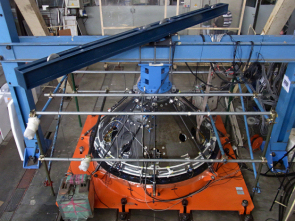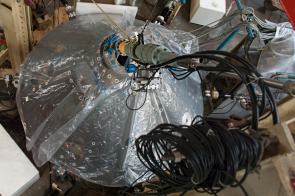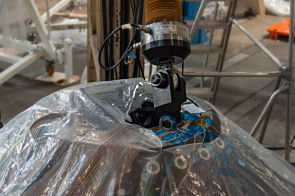ExoMars 2016 Test Campaign Journal: #02 - Entry, Descent and Landing Demonstrator Module completes mechanical tests
17 October 2013
The Structural Model (SM) of the Entry, Descent and Landing Demonstrator Module (EDM) has successfully completed its mechanical qualification testing.Having undergone vibration testing at ESA's European Space Research and Technology Centre (ESTEC) in Noordwijk, the Netherlands earlier in the year, the EDM SM was returned to the Turin facility of Thales Alenia Space for further mechanical testing.
Entry load test
The EDM - a technology demonstration vehicle carried by the ExoMars Trace Gas Orbiter - will be launched in 2016 on a nine-month journey to Mars. Three days before reaching the atmosphere of Mars, the EDM will separate from the Orbiter and coast towards the planet before entering the Martian atmosphere. During aerobraking the EDM will experience a deceleration of up to 15g. This means that the spacecraft, which weighs roughly 600 kg, will be loaded with forces equivalent to a weight of nine tonnes.
 |
 |
| The ExoMars EDM Structural Model during the entry load test. Credit: ESA/B. Bethge | |
To simulate the pressure exerted on the front shield structure by this manoeuvre, the SM was placed in a special jig equipped with an air bag to press on the shield. Simultaneously, an internal hydraulic jack pushed vertically down on the surface platform fixture plate in order to simulate the inertial load induced by the EDM deceleration during the entry phase. A metal plate linked to the three anchor points on the upper ring reacted to the applied load by means of eight steel bars connected to the cylinder used for the airbag accommodation in order to provide a proper stress distribution on the back cover and to unload the upper interface of the EDM SM. The 2.4 m diameter air bag was inflated to a pressure of 0.2 bar while 270 strain gauges monitored the behaviour of the structure.
Parachute pull test
Once the aerobraking manoeuvre has slowed the EDM sufficiently, a parachute system will be deployed to further reduce the speed prior to landing. The parachute system will be attached to the EDM by three bridles. In the worst-case scenarios, the parachute force would be applied to the EDM through only one bridle. The two worst-case pull angles were simulated during the parachute pull test.
 |
 |
| The ExoMars EDM Structural Model during the parachute pull test. Credit: ESA/B. Bethge | |
What happens next?
Work has started on building an avionics test bench, which will be used to test and qualify the EDM onboard software. Construction of the Proto-Flight Model (PFM) EDM hardware will begin in early 2014 and the subsystems are currently undergoing qualification. The PFM will be assembled in a special cleanroom (ISO 7 / Class 10 000 – 10 times cleaner than a normal spacecraft cleanroom) due to planetary protection requirements; the atmosphere will be regularly monitored for particulate and bacterial contamination.
About the ExoMars 2016 Mission
The first mission of the ExoMars programme, which is scheduled to arrive at Mars in 2016, consists of a Trace Gas Orbiter (TGO) and an Entry, descent and landing Demonstrator Module (EDM), called Schiaparelli. The main objectives of this mission are to search for evidence of methane and other trace atmospheric gases that could indicate active biological or geological processes and to test key technologies in preparation for ESA's contribution to subsequent missions to Mars.
The ExoMars 2016 mission is led by ESA, with partner Roscosmos supplying the launcher and two of the four instruments of the scientific payload. The other two instruments are provided by European Consortia. The Prime Contractors are Thales Alenia Space (Italy) for the overall spacecraft and Schiaparelli, while the TGO is being built by Thales Alenia Space (France) together with Co-Prime OHB (Germany).




